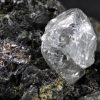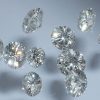Diamond is the most elegant gemstone and sought after for its gem quality and transparent crystalline form, which makes it look good on anyone. It is the hardest substance present on the surface of the earth and thus is the most solid form of carbon element. Despite being a very hard and exceptional substance, its chemical formula isn’t very complex, which is amusing; it is just C which, of course, means carbon and has nothing else other than carbon. Although we know about numerous other carbon substances diamond is superior to them all because of all the qualities that it possesses. Chemistry tells us more about the diamond in a very technical way; it says that diamond is a mineral composed of carbon. Diamond is said to be an allotrope of carbon elements as it exists in more than one kind of physical form. The use of diamond is not limited to jewelry, but it is also used in various cutting tools because it being the hardest substance, cuts through any material or substance with ease without being damaged. That being said, let’s have a look structure of the diamond.
Structure of Diamond:
The structure that the diamond has is because of how carbon atoms are bonded; if we look at a diamond crystal, its structure is attained by the tetrahedral bonding of carbon atoms. Thus, it forms a three-dimensional skeleton that is infinite. The tetrahedral bonding of carbon atoms is done by forming a covalent bond of four carbon atoms in the SP3 hybrid orbitals. The C-C bond in a diamond being strongest allows no valence electrons; thereby, the valence electrons get involved in forming covalent bonds; as a result, the diamond has no free electrons. Having no free electrons and a strong C-C bond is what makes the diamond so hard but not just hard. Along with this, it also has a very high melting point and zero electric conductivity but has the highest thermal conductivity. It has a very low coefficient of thermal expansion, adhesion, and friction. It being chemically inert doesn’t react with even the most corrosive elements. The reason behind diamond attaining all these properties is solely its structure which has been possible because of the tetrahedral bonding of its carbon atoms. A competitive synthetic diamond manufacturer would know if a diamond is of good quality or not just by the look of its crystals because it’s all in the structure of the diamond that makes it so precious.
The hardness of Diamond:
The hardness of the diamond is talked about the most among all its other properties of it. The reason behind it is that every other substance that is on the list of hardest elements is in no way near the diamond. In carving, if you would use a mineral to carve the other mineral, one of the minerals will certainly get damaged in the process, but diamond won’t. It is the only mineral that can scratch any mineral, but no mineral can scratch it whatsoever, so you can imagine how hard the diamond would be. According to the Mohs hardness scale, its hardness is 10, and thus its cutting and processing can only be done by diamond powder. However, its new Mohs hardness is 15, and if we look at its microhardness, that is around 10000kg/mm2, which is almost 150 times more than corundum and 1000 times more than Shi Ying. The different grades of the diamond as obtained by the difference of hardness; every grade has a different hardness. In that, talc is grade 1; gypsum is grade 2; calcite is grade 3; fluorite is grade 4; apatite is grade 5; orthoclase is grade 6; Shi Ying is grade 7; topaz is grade 8; corundum is grade 9, and diamonds are grade 10.
4 Cs of Diamond:
The characteristics of the diamond are collectively called four C’s, which basically mean carat, color, clarity, and cut. These four things are what determine the price of a diamond; the weight of a diamond is measured in carats like 1/5 gram is equal to one carat. The color of diamonds is also an important factor as most people love colorless diamonds, which are diamonds in between the range of grade D to grade F. Colored diamonds are also popular but not more than colorless diamonds. Diamonds are born with impurities and blemishes, so the clarity of the diamond defines the number of impurities that are a part of a diamond. The last C is the cut which is of equal significance as it tells how light will be reflected from the diamond.


